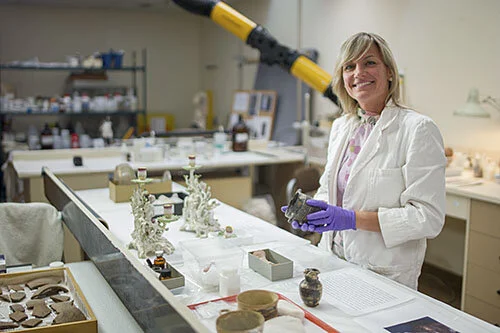Laura Lipcsei
An interview with the Senior Conservator of Ceramics, Stone and Glass at the Royal Ontario Museum.
How do you describe your work?
I am an objects conservator at the ROM, which means I am responsible for the examination, condition reporting, and conservation treatment of ceramic, stone and glass objects in the Royal Ontario Museum’s encyclopaedic collection. This covers ancient archaeological, historical and decorative art artifacts destined for exhibition, loan, gallery rotation, technical and art historical study and acquisition.
It is our mission to preserve and care for objects in the ROM’s collection in perpetuity, for the continued enjoyment of our common heritage. With almost 5 million objects in the ROM’s collection, we cannot possibly work on each and every object. Our work is usually driven by set of priorities, for example, objects that are needed for exhibition and/or loan, curatorial study or, objects that are in dire need of physical or chemical stabilization treatment. Conservation touches almost all areas of the museum. On any given work day, I might find myself working with staff from almost any department, whether it be a curator, technician, preparator, exhibit designer or registrar, just to name a few!
What career/educational path did you take to get here?
I studied Classical Literature and Archaeology at Queen’s University, where I obtained my Bachelor of Arts, Honours. I was so drawn to the archaeology, and the art and architecture of the ancient world, that I continued my studies at the graduate level at the University of Toronto where I completed a Master’s Degree in Archaeology and Ancient Studies. When working on archaeological excavations in Italy, Greece, Turkey and Tunisia; and visiting museums in cities around the world, I saw the work of art conservators and learned about art conservation. I was fascinated by this ‘new’ (to me) profession that focused on both art and science – two seemingly opposed fields. Conservation is a discipline that not only looks an object’s form, but also - and very importantly – how the object was made, and how it deteriorates, so that we can work to preserve the object today, hopefully for perpetuity. I went back to Queen’s University to get a Master’s Degree in Art Conservation, but not before completing two important prerequisites: two university level chemistry courses -organic and inorganic chemistry. Also essential to applying to the program was having internship experience working with a conservator at a museum or in private practice.
What is the most exciting part of your work?
I think the most exciting part of what I do is carrying out authentication studies to try to unravel the mysteries of how an object was made – I need to consider both the technique of its manufacture and the materials that were used in its creation to figure out if it is “real” or not. To do this, I, with the help of my colleagues, employ all kinds of analytical techniques to look at an object’s chemistry and its physical characteristics. In my lab, I have access to other non destructive techniques including specialized lighting, such as ultraviolet or Infrared radiation as well as X rays, CT scans and high powered microscopes.
What is your biggest challenge?
I think the biggest challenge is getting people (curators and the general public) to understand what I do! I need to get information out about what conservation is, and what it can do! Remarkably, conservation is still a relatively small field. Some art historians and curators still do not know that in addition to cleaning and caring for objects, that conservators actually look at art objects/artifacts from a scientific and material point of view. This is important because the form and historical context of an object is really only half of the story – the other half is the science of what the thing is made of and how it was made. It is only by working together that we are able to give the whole picture - a holistic view about what the object is and to place it into its continuum of art and tradition.
Tell us a brief story about an object you have worked with.
Recently I worked on a wonderful collaborative project to authenticate an ancient 5th century AD ceramic Zapotec urn from Oaxaca Valley Mexico. It took a team of experts gathered from around the world – each one of us in our area of expertise, as archaeologists, curators, scientists, conservation scientists, conservators and technicians, all using various techniques of scientific analyses and art connoisseurship to determine whether in fact the urn was “real” or “fake”. Our work culminated in an e-book publication on the subject, which is free for download from the ROM website.
Anything to add especially for artists, designers, makers and crafters?
I think conservators care about many of the same things artists do! In training and throughout our careers, conservators spend a great deal of time thinking about how works of art were made, in order to preserve them. Before conservation school, many of us were artists or have a background in the fine arts. In fact, when applying to conservation school, applicants must prepare a portfolio to demonstrate a certain degree of artistic skill and to show an understanding of various media. After all, a part of what we do involves restoration, to integrate losses, fill voids, and, at times, mask areas of damage so the object is able to tell its story without distraction.
Contemporary art is an exciting specialization for the art conservator, as so many living artists today have unique approaches to their art and to their media. As conservators, we need to know what the materials were that were used in a given work of art so that we can predict how they will age or degrade, and thereby be ready and able to treat these objects, halt their deterioration and preserve them accordingly. The challenge with contemporary art is that sometimes the artist may not care to remember the materials they used in creating their work of art, or the information maybe lost or missing. Once the work of art is finished, as is often the case with spontaneous and ephemeral works, the artists may not care what happens to the work of art once it has been created – as perhaps the intention was to have the work be ephemeral, spontaneous and fleeting. This poses a great challenge to the art conservator, as our main purpose is to preserve objects, but also to maintain the artist’s intent, which as you can see, in this case, puts us at odds with our very purpose of attempting to do our jobs!
Some of the most rewarding collaborations are those that conservators can have with artists – for example when carrying out replication experiments. These are experiments where conservators and artists work together to recreate an ancient technique or process in order to understand how an ancient artifact was made. These studies are especially useful when explicit information about these ancient techniques are missing or are unclear.
Laura Lipcsei is the Senior Conservator of Ceramics, Stone and Glass at the Royal Ontario Museum. Laura has worked at museums across North America, including the Museum of Fine Arts in Boston and the Metropolitan Museum of Art in New York City. She has worked as site conservator and excavated as an archaeologist for projects in Italy, Greece, Turkey and Tunisia. As a result of her training and experience Laura has a special interest in the art of the Ancient Mediterranean. Over the course of her career, Laura has travelled extensively with touring exhibitions and loan programs to Asia and Europe.
This article was published in the Spring/Summer 2020 issue of Studio Magazine.







